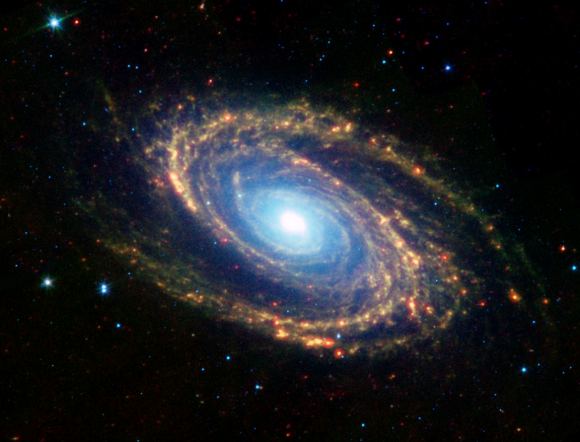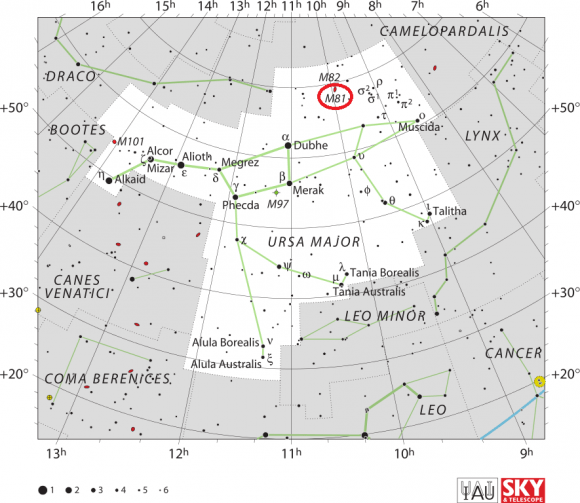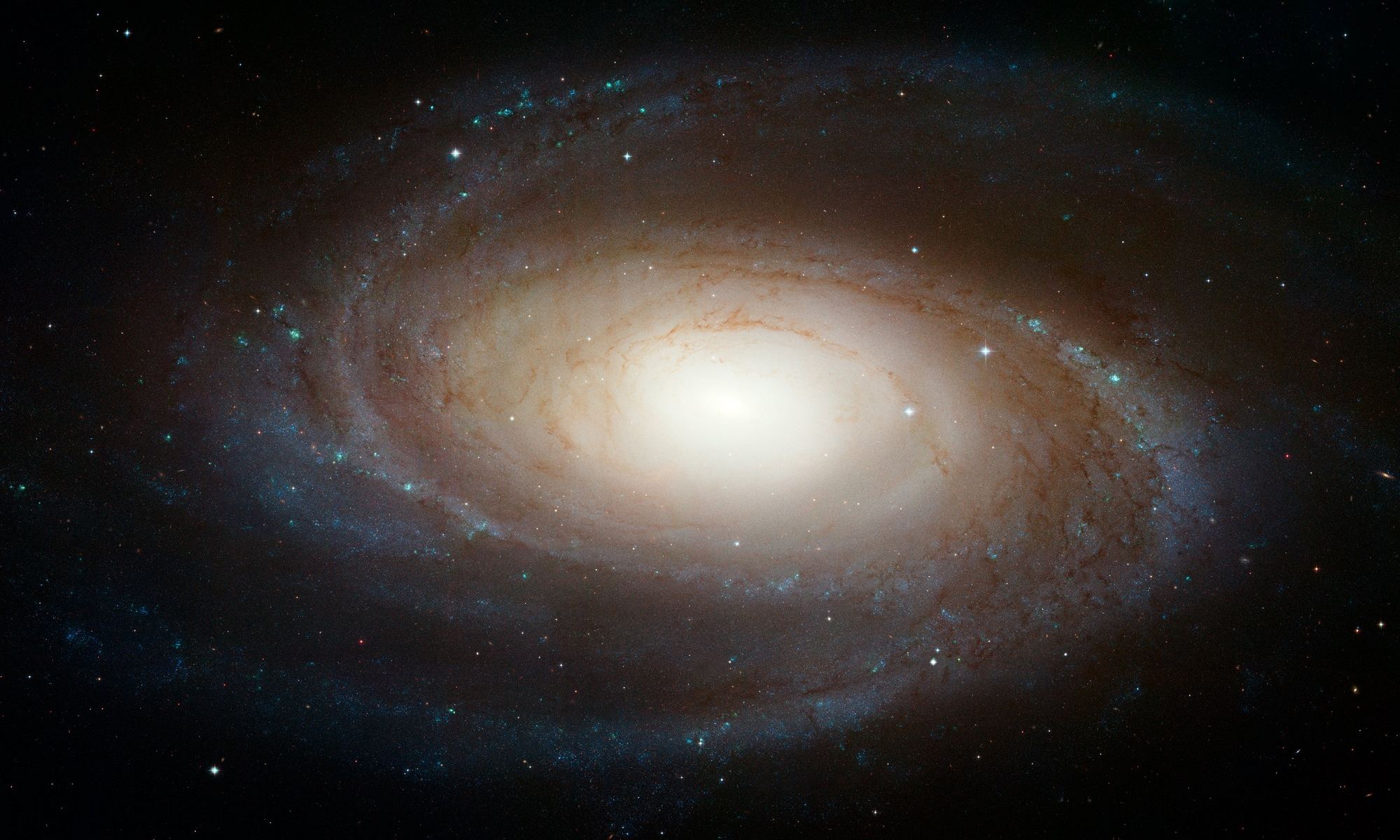Welcome back to Messier Monday! Today, we continue in our tribute to our dear friend, Tammy Plotner, by looking at the Bode’s Galaxy – also known as Messier 81!
During the 18th century, famed French astronomer Charles Messier noticed the presence of several “nebulous objects” while surveying the night sky. Originally mistaking these objects for comets, he began to catalog them so that others would not make the same mistake. Today, the resulting list (known as the Messier Catalog) includes over 100 objects and is one of the most influential catalogs of Deep Space Objects.
One of these objects is the galaxy known as Messier 81 (aka. Bode’s Galaxy), a spiral galaxy located about 12 million light-years from our Solar System. Measuring about 90,000 light-years in diameter (half the size of the Milky Way), this galaxy’s proximity, large size, and active galactic nuclear (AGN) makes its a favorite among professional and amateur astronomers alike.
Description:
This grand design spiral galaxy definitely stands out as the leader in the Local M81/82 Group. At one time, several billion years ago, the pair interacted with each other. Even today they remain close… their centers separated by a linear distance of only about 150,000 light years. By investigating Cepheid variables, astronomers have determined M81 to be approximately 11 million light years away. Can you imagine how bright it would be had it been closer?!
One of the most fascinating things to look at when viewing Messier 81 is its impenetrable core region. There’s good reason, too… It’s incredibly dense. As N. Bartel (et al) said in a 1995 study:
“Very-long-baseline radio interferometry images of the nuclear region of the nearby spiral galaxy M81 reveal the most compact galactic core outside the Galaxy of which the size has been determined: 700 x 300 astronomical units (AU). The observations exclude a starburst or supernova interpretation for the core. Instead they favor an active galactic nucleus.”
And not only is the nucleus a fascination, but the smooth spiral structure as well. After all, look at how many stars it gathered in when the two combined! Just imagine all that dust creating new ones… As K. D. Gordon (et al) indicated in a 2004 study, they presented images that revealed:
“[A] bright nucleus and two well resolved spiral arms studded with bright regions of star formation. These images show that M81 has a significant amount of cold dust associated with the spiral arms. From multiwavelength morphology comparisons, the dust heating is argued be dominated by recent star formation even at the longest MIPS wavelength. The resolved UV and Ha SFRs are always lower than the IR SFRs indicating significant dust attenuation, radiative transfer effects, and/or different stellar ages than assumed. The character of the dust attenuation indicates that the dust geometry and/or grain properties are different for resolved regions in M81 than in starburst galaxies. The infrared-radio correlation was found to vary by a factor of ~6 in the M81 with coherent structures relating to the spiral arms. These results illustrates the need for additional theoretical and empirical work on how to accurately combine different SFR indicators, accounting for dust, age, and radiative transfer effects, to give an accurate view of the star formation in regions of galaxies.”
But there are holes there… And not necessarily black ones! As Ioannis Bagetakos (et al) explained in a 2007 study:
“The data show a stunning amount of detail in the form of 330 expanding shells and holes in the neutral ISM of M81. A comparison with the holes found in two other spirals and two dwarf galaxies reveals that the ISM in M81 shares a lot of similarities with the two spirals, whereas the structure of its ISM is different to that in dwarf galaxies. The two properties which most clearly illustrate this are the size distribution of the HI holes and their distribution in velocity. Our observations reinforce the idea that the amount of energy typically deposited in the ISM is the same, irrespective of galaxy type, but that the properties of HI holes depend on the characteristics of the host galaxy, notably the thickness of the neutral gas layer.” “Also, there seems to be a clear indication that HI holes in spiral galaxies are shorter-lived, most likely due to the combined effects of shear and spiral density waves.”
History of Observation:
M81 is the first of the four deep space beauties discovered by Johann Elert Bode, who found it the pair on December 31, 1774. According to his historical notes:
“I found through the seven-foot telescope, closely above the head of UMa, east near the star d at its ear, two small nebulous patches separated by about 0.75 degrees, the positions of which relative to the neighbored small stars are shown in the tenth figure. The patch Alpha (M81) appears mostly round and has a dense nucleus in the middle. The other, Beta, on the other hand, is very pale and of elongated shape. I could determine the separation of Alpha to d as 2deg 7′, to Rho as 5deg 2′ and to 2 Sigma as 4deg 32′ with some accuracy; Beta was too faint and disappeared from my eyes as soon as I shifted apart the halves of the objective glass.”

Pierre Mechain independently recovered both galaxies in August 1779 and reported them to Charles Messier, who added them to his catalog after taking data on February 9, 1781. As Messier reported:
“A nebula near the ear of the great Bear [Ursa Major], on the parallel of the star d, of fourth or fifth magnitude: its position was determined from that star. This nebula is a little oval, the center clear, and one can see it well in an ordinary telescope of 3.5 feet.”
All historical observers note the bright nucleus, but to for Emil Dreyer to give it an exclamation point in his own personal notes is a rarity… says he: “Remarkable, extremely bright, extremely large, extended in position angle 156 degrees, gradually, then suddenly very much brighter toward the middle where there is a bright nucleus.”
Locating Messier 81:
Bright M81 is fairly easy to find – once you catch on to a certain trick. By using the lower star closest to the “handle” in the bowl of the Big Dipper, draw a mental line between it and Alpha – the top outside star of the asterism. Now follow the same trajectory and extend that line approximately 1/3 further into space and you’ll have the approximate area!

Once you are there, both M81 and companion galaxy M82 are easy to spot in a finderscope or small binoculars. With minimal magnification, the pair of galaxies will appear like to small “cat’s eyes” glowing in the dark. Because of the relative brightness, both stand up well to urban lighting conditions and a great deal of Moon interference. The galactic pair makes a wonderful study for small telescopes and binoculars!
May it inspire you tonight!
Object Name: Messier 81
Alternative Designations: M81, NGC 3031, Bode’s Nebula
Object Type: Sb – Barred Spiral Galaxy
Constellation: Ursa Major
Right Ascension: 09 : 55.6 (h:m)
Declination: +69 : 04 (deg:m)
Distance: 12000 (kly)
Visual Brightness: 6.9 (mag)
Apparent Dimension: 21×10 (arc min)
We have written many interesting articles about Messier Objects and globular clusters here at Universe Today. Here’s Tammy Plotner’s Introduction to the Messier Objects, M1 – The Crab Nebula, Observing Spotlight – Whatever Happened to Messier 71?, and David Dickison’s articles on the 2013 and 2014 Messier Marathons.
Be sure to check out our complete Messier Catalog. And for more information, check out the SEDS Messier Database.
Sources:
- NASA – Messier 81
- Wikipedia – Messier 81
- Messier Objects – Messier 81
- Hubble Space Telescope – Messier 81

